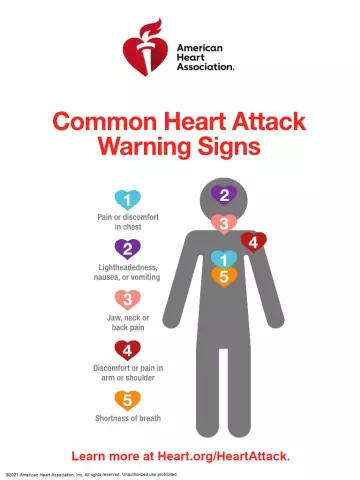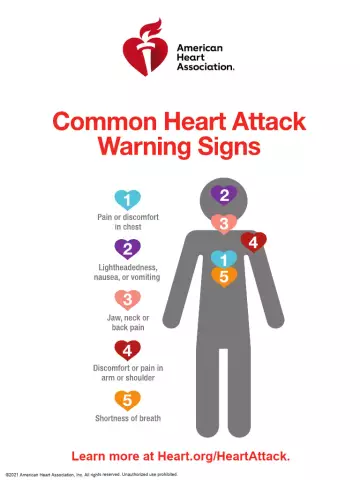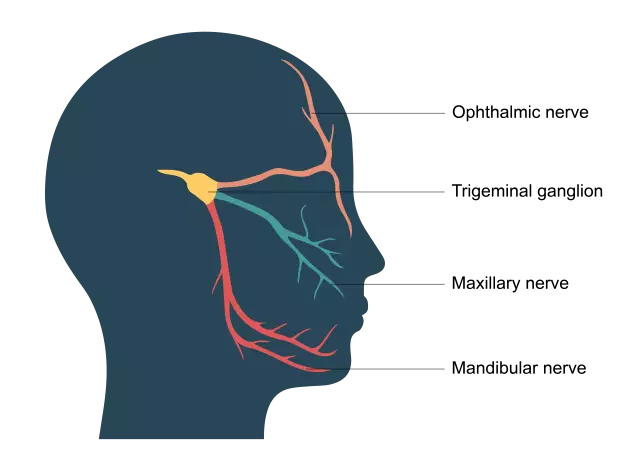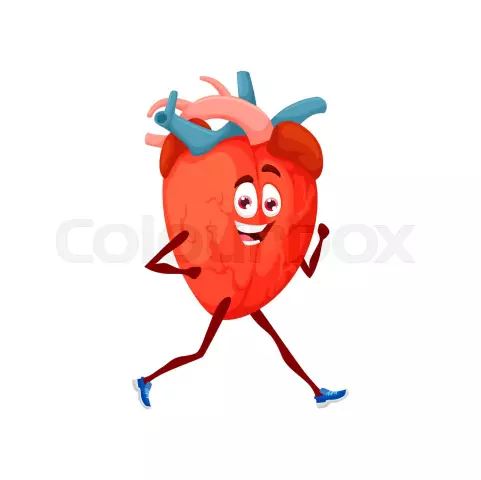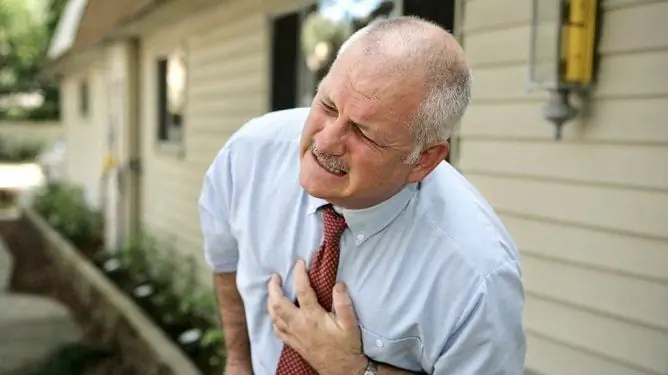- Author Rachel Wainwright [email protected].
- Public 2023-12-15 07:39.
- Last modified 2025-11-02 20:14.
Heart
The heart is a hollow muscular organ with a conical shape. Its main function is to pump the blood flowing into it through the venous trunks into the artery. Relaxation of the heart muscle is called diastole, and contraction is called systole.

Heart structure
The heart is located on the left side of the chest. Outside, it is covered by the pericardium, which forms a heart bag, inside which contains a small amount of serous fluid. The middle muscle of the heart is called the myocardium. Inside, the heart cavity is divided by partitions into four chambers: two atria and two ventricles. Blood enters the left atrium through the pulmonary veins, and into the right atrium through the vena cava. The ascending aortic arch leaves the left ventricle, and the pulmonary arteries that form the pulmonary trunk from the right ventricle. Inside the chambers, the heart is covered with an extremely smooth membrane - the epicardium.
The right atrium and left ventricle complete the systemic circulation, and the left atrium and right ventricle complete the small circle.
The structure of the heart in the right and left sections is different. So, for example, the walls of the right ventricle are almost three times thinner than the left ventricle. This is due to the fact that with the reduction of the latter, blood is pushed out into the systemic circulation and goes to all organs and tissues of the body. In addition, the resistance and pressure in the large circle is much higher than in the small one.
Heart valve apparatus
The structure of the heart is unique, because the blood in it flows in only one direction. This is provided by its valve apparatus. The valves open at the right time, allowing blood flow, or vice versa, close, preventing the reverse flow (regurgitation).
Between the left ventricle and the atrium is a bicuspid (mitral) valve. It has two doors. At the time of its opening, blood from the left atrium through the atrioventricular opening enters the left ventricle. With the contraction (systole) of the left ventricle, the valve cusps close, and blood rushes into the aorta.
The tricuspid or tricuspid valve is located between the right ventricle and the atria. At the moment of its opening, blood flows freely from the right atrium to the right ventricle. The cusps of this valve are closed at the moment of right ventricular systole. As a result, blood cannot flow back into the atrium and is pushed into the pulmonary trunk.
At the very beginning of the pulmonary trunk, there is another valve, the function of which is to prevent backflow of blood into the right ventricle during its diastole.
The entrance to the aorta is closed by the aortic valve, which has three semilunar cusps. It opens at the time of left ventricular systole and closes at its diastole.
Many heart diseases are caused by the pathology of its valve apparatus.
Blood supply to the heart
Two coronary (coronary) arteries extend directly from the aorta. They disperse into many branches, which, like a crown, twine around the entire heart, providing oxygen and nutrients to each of its cells. A fifth of the total volume of blood ejected into the aorta passes through the coronary arteries.
Regulation of the heart
Contractions and relaxation of the heart are regulated by the potassium and calcium ions contained in the blood, as well as by the endocrine and nervous systems. The nervous system is directly involved in the regulation of the strength and heart rate. The parasympathetic nervous system weakens the effort of contractions, and the sympathetic, on the contrary, enhances them.
The endocrine system affects the work of the heart through hormones that can lead to changes in heart rate, increase or decrease. The adrenal cortex hormones, acetylcholine and adrenaline, are of the greatest importance for regulating the activity of the heart; their action is similar to the effect on the myocardium of the parasympathetic and sympathetic nervous systems.
Heart diseases
In recent years, mortality from cardiovascular diseases has been increasing throughout the world. All heart diseases, depending on the cause and nature of their occurrence, can be conditionally divided into several groups:
- Functional;
- Congenital;
- Atherosclerotic and hypertensive;
- Syphilitic;
- Rheumatic.
In addition, there are a number of heart diseases that do not fall into the categories listed above and should be discussed separately. These include:
- Acute dilatation (expansion) of the heart. This pathology occurs as a result of severe myocardial weakness and overloading of the heart with a large volume of blood;
- Atrial flutter - consists in an accelerated regular contraction of the atria, behind which the ventricles do not have time to contract;
- Atrial fibrillation - in this condition, there is a chaotic accelerated contraction of individual muscle fibers of the atria, as a result of which a full-fledged systole is not observed. Atrial fibrillation is observed against the background of heart failure;
- Paroxysmal tachycardia - recurring attacks of sharply increased heart rate;
- Thrombosis of coronary vessels arising on the background of atherosclerosis;
- Myocardial infarction;
- Heart failure, which is the ultimate outcome of any heart disease.
Diagnosis of heart disease
Modern medicine has great opportunities for accurate and timely diagnosis of heart disease. Among the instrumental methods in cardiology, X-ray, electrophysiological and electrocardiographic studies, catheterization of cardiac vessels, echocardiography, positron emission and magnetic resonance imaging are most often used. The risk of diagnosing heart disease is low, which increases with the severity of the disease and the technical complexity of the procedure.
Cardiology: Treating the Heart
Cardiologists treat heart diseases. Heart treatments can be conservative or surgical. Surgical intervention is indicated for numerous defects of the valve apparatus. In this case, reconstructive operations are performed or worn-out valves are replaced with artificial ones. Surgical operations are also performed for a number of congenital heart defects.
Conservative treatment of the heart is carried out in the case of arrhythmias, coronary heart disease, heart failure. With the ineffectiveness of conservative therapy, there are indications for surgical intervention.
Found a mistake in the text? Select it and press Ctrl + Enter.


